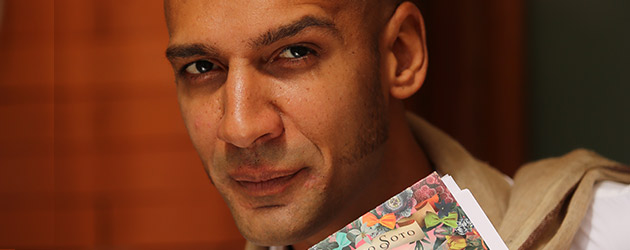Interview & photos: Rafael Manjavacas
From Jerez de la Frontera, Fernando Soto Valencia, singer of the festive flamenco forms whom we got to know thanks to his cousin Pitingo who always put him up front in his recitals.
Now, he’s brought out a recording, “Bambineando”, with ten songs of the maestro from Utrera – sevillanas, rumbas, flamenco songs – with guest artists like Salmarina, Gala Évora and of course, Pitingo.
In Jerez, so important for flamenco, it seems easy to be a performing artist, but not really…
It’s not easy there or anywhere else. Coming from Jerez is important, an artist has to find definition in a style, have a presence and a way of singing and expressing the artform.
You define yourself through rumba and Spanish lyrical song. When did you make that decision?
Actually, when I was very small. I’ve always been a fiesta performer of bulerías and tangos, I’m not the kind of singer to sit in a chair, there are fine artists who do that very well. What I do is also difficult, not everyone can do it, just like classic flamenco.
“Bambino”, that’s quite a mouthful…he was very admired within the world of flamenco.
Tell me about it, I’ve had butterflies in my stomach for seven months. He was a fiesta specialist, and number one in that line, along with Lola Flores.
Having a good sense of rhythm is a big help for the forms you do, rumba and the rest…
I’ve got the rhythm inside of me since birth, I’m from Jerez. The rhythm of lyrical song I do differently, bringing it to my own beat in another context that others aren’t able to do.
How did you deal with the challenge of adapting the art of Bambino to your personality?
Bambino has close to 700 songs recorded… I listened to them all in two weeks. It was very hard…just like El Pescaílla is rumba catalana, Bambino is rumba andaluza, and to adapt those rumbas to Fernando Soto was like pulling teeth, because I wanted to do it right, I didn’t want to imitate Bambino but rather remember him, his songs and his style, and bring it all to our own times.
And what does the new century contribute?
A fresh flavor, today’s sound is different from what used to be, there’s evolution in the rhythm and the swing, before it was 3×2, now we can do it in 4, 5, 6…however we want, we play around with the tempos, that’s what makes this recording different, the rhythms, the tempos and the music.
Are all the songs from Bambino?
Everything…from those 700 songs, I tried to select the least-known…the same ones have always been done, and I wanted to use things that haven’t been so worked over. Everything is Bambino, but it’s songs from Latin America, Olga Guillot…things that Bambino made his own.
Tell me about some of the more important pieces.
Bambineando por Sevillanas and Bambineando por Rumbas are the catchiest numbers because it’s what people know, I adapted a potpourri of sevillanas, Corazón Loco, Bravo, La Pared…but made into sevillanas, and I think it works very well.
Bambineando…that’s the same title Marina Heredia used with Monica Naranjo.
In actual fact, I think they came out at the same time…I didn’t know she was going to do it, and she didn’t know what I was doing, it was just a coincidence…and there was Bambino…
Who collaborated on this record?
Gala Evora, Salmarina, José Gálvez, a great composer and singer from Jerez, Pitingo, José Miguel Évora, also Manuel Parrilla, Pedro Pimental my guitarist. A group of very good artists and friends of mine.
You were with Pitingo a long time…was that an enriching experience for you?
Absolutely….I’ve been singing and dancing all my life, but he put me on the map, he gave me the opportunity to be known and I’ll owe that to him until the day I die. He’s my artistic godfather.
What artists do you admire, aside from Bambino of course…and in flamenco?
Lola Flores is the muse, Manolo Caracol, Paquera de Jerez…and I’m crazy for Sernita…I don’t think he’s received the attention he deserves.
You also worked in tablaos…
Yes, from the age of 14…and even now, if they called me I’d go, that’s where the ‘duende’ and the heart of flamenco is, in the tablaos, we must never forget this, it’s where we come from. In the days of Paco de Lucía the best artists worked in theaters, but they also worked in tablaos. Manolo Caracol sang in the tablao every night.
We’ve seen you on many televisión programs where your kind of singing is an easy sell, but concerts aren’t so easy, there aren’t many venues.
Things are bad, but thank goodness there are places… I’m going to present my record in Barcelona, Seville, Valencia…in all the capitals. Even in flamenco festivals, the few that remain. And in Madrid…I’ll be in the just renovated Cantares on November 7 to present my new record.
